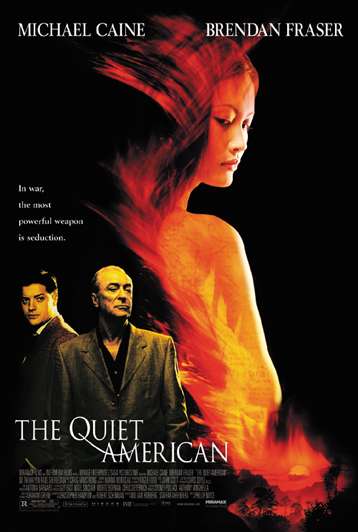The Quiet American

The Quiet American is a novel written in 1955 by Graham Greene. It was made into a movie on two occasions, in 1958 by Joseph L. Mankiewicz and in 2002 by Philip Noyce.
The story takes place in Indochina, during the last days of the French presence. The war for Vietnam's independence has been raging for years and the French are losing. Thomas Fowler is an aging and emotionally detached British journalist who treats his assignment in Saigon as a way to live in lazy self-indulgence, far from his wife and his boss; he has taken up a much younger Vietnamese girl, Phuong, as a mistress. He one day meets Alden Pyle, a young and idealistic American expatriate, ostensibly in Vietnam with a medical mission. Pyle begins to compete with Fowler for the attention of Phuong.
- Asian Gal with White Guy: Phuong and both Fowler and Pyle.
- But I Read a Book About It: Fowler is irritated with Pyle in part because the latter relies entirely too much on what the "experts" say and doesn't seem to value Fowler's practical experience.
- Call Forward: The bit in the second adaptation where Pyle's Vietnamese allies massacre a bunch of villagers for basically no reason at all can be seen as foreshadowing the atrocities committed by both the ARVN and American forces--think My Lai--during The Vietnam War.
- Eagle Land: An especially harsh instance of this.
- The Film of the Book: The first film adaptation completely changed the message of the story, assuming that Pyle couldn't possibly be a Villain since a) he was American and b) he had good intentions. The second adaptation was much closer to the original.
- The original may actually have been a deliberate Take That to Graham Greene; Edward Lansdale, who might have been the inspiration for Pyle was involved in the script. Ironically, the second film actually goes the complete other direction amongst other things, it adds a scene where Pyle's Vietnamese allies massacre villagers For the Evulz and changes Pyle's character to make him rather less sympathetic.
- Foreign Correspondent
- Gratuitous Vietnamese: Pyle's Vietnamese lines.
- Holiday in Cambodia: Indochina is depicted as a war-torn land, where even well-intentioned people make morally murky decision as the cost of taking sides.
- How We Got Here: The story is told in flashback mode from Fowler's perspective.
- Ironic Echo: Pyle is ostensibly in Vietnam to cure and prevent trachoma, an illness which causes blindness. The final image in the film is of an American soldier in Vietnam blinded after battle.
- Love Triangle
- May-December Romance: Fowler is past middle age while Phuong is barely out of her teens.
- Obfuscating Stupidity: Pyle is smarter than he lets on, and although he feigns not to speak Vietnamese, he is in fact fluent in it.
- This scene is only in the second film. The novel suggests that Pyle was genuinely far out of his depth.
- Opium Den
- Sliding Scale of Idealism Versus Cynicism: Fowler is a cynic, Pyle an idealist. Guess who turns out to be right.
- Take a Third Option: Pyle thinks that his idea of a "Third Force" is the third option in the struggle between colonialism and communism.
- Title Drop: "He was a quiet American."
- Unreliable Narrator: Fowler may well be this in the novel.
- The Vietnam War: The story shows how Americans first began to get embroiled in Vietnam.
- Well-Intentioned Extremist: What Pyle turns out to be, considering he's been helping the nationalists manufacture and plant bombs.
- What Do You Mean Its Not Symbolic: Phuong symbolizes Vietnam. Lampshaded by Pyle: "Let's just look at Phuong. There's beauty. Daughter of a professor. Taxi dancer. Mistress of an older European man. That pretty well describes the whole country."
- Further extended, Phuong represents the developing world as a whole, Fowler represents the aging--nay, dying--old European powers, and Pyle represents the Americans who, in replacing the Europeans, do not realize exactly how unsavory their new position requires them to be.
- Where Are They Now? Epilogue: The epilogue displays newspaper articles written by Fowler in the years after Pyle's death, as the Americans begin to deploy troops in Vietnam and the war escalates.